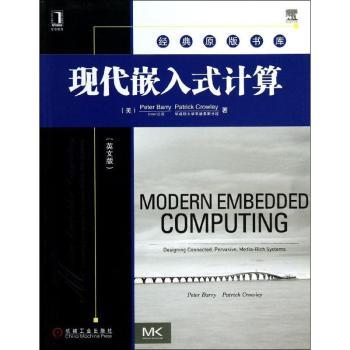内容简介
不像嵌入式微控制器只执行面向工业应用的有限功能,现代嵌入式系统是互连、富媒体的(利用网络功能和图形用户接口)。《现代嵌入式计算(英文版)》讲述当代嵌入式计算系统的平台架构,这些嵌入式系统能够驱动普适、互连的设备(如移动电话、数字照相机、智能家居系统)。
intel
atom处理器广泛用于如电子阅读器、连网电视、平板电脑、笔记本电脑这样的设备,全书一开始就讨论嵌入式平台架构和专用于intel
atom处理器的架构,接下来分别讨论系统启动、操作系统、功耗优化、图形和多媒体加速、网络连通性、平台调试。本书全面介绍了如何开发嵌入式片上系统(soc)框架,既适合作为高校嵌入式计算课程的教材,也适合嵌入式系统设计人员及相关专业人员阅读参考。
本书
采用基于主流pc芯片架构的intel atom处理器学习嵌入式系统设计,并提供与其他平台的对比分析。
设计面向支持游戏、车载信息娱乐系统、医疗记录检索、销售点购买、联网、数字存储以及其他、消费和工业应用的嵌入式处理器。
目录
preface
foreword
acknowledgments
part 1 principles of modern embedded systems
chapter 1 embedded systems landscape
what is an embedded computer system?
why is this transition inevitable?
what range of embedded systems exists?.
what to expect from the rest of this book
chapter 2 attributes of embedded systems
embedded platform characteristics
summary
chapter 3 the future of embedded systems
technology trends
issues, applications, and initiatives
challenges and uncertainties
summary
part 2 embedded systems architecture and operation
chapter 4 embedded platform architecture
platform overview
volatile memory technologies
nonvolatile storage
device interface--high performance
universal serial bus.
device interconnect--low performance
general-purpose input/output
power delivery
summary
chapter 5 embedded processor architecture
basic execution environment
application binary interface.
processor instruction classes
exceptions/interrupts model
vector table structure
exception frame
masking interrupts
acknowledging interrupts
interrupt latency
memory mapping and protection
memory management unit
mmu and processes
memory hierarchy
intel atom microarchitecture (supplemental material)
chapter 6 embedded platform boot sequence
multi-core and multi-processor boot
boot technology considerations
hardware power sequences (the pre-pre-boot)
reset: the first few steps and a jump
early initialization
ap processor initialization
advanced initialization
legacy bios and uefi framework software
cold and warm boot
summary
chapter 7 operating systems overview
application interface
processes, tasks, and threads
scheduling
memory allocation
clocks and timers
mutual exclusion/synchronization
device driver models
bus drivers
networking
storage file systems
power management
real time
licensing
chapter 8 embedded linux,
tool chain
anatomy of an embedded linux
building a kernel
debugging
driver development
memory management
synchronization/locking.
summary
chapter 9 power optimization
power basics
the power profile of an embedded computing system
constant versus dynamic power
a simple model of power efficiency
advanced configuration and power interface (acpi)
optimizing software for power performance
summary
chapter 10 embedded graphics and multimedia acceleration
screen display
embedded pannels
graphics stack
accelerated media decode
video capture and encoding
media frameworks
summary
chapter 11 digital signal processing using general-purpose
processors
overview
single instruction multiple data
microarchitecture considerations
implementation options
intrinsics and data types
vectorization
performance primitives
finite impulse res




 VIP会员
VIP会员